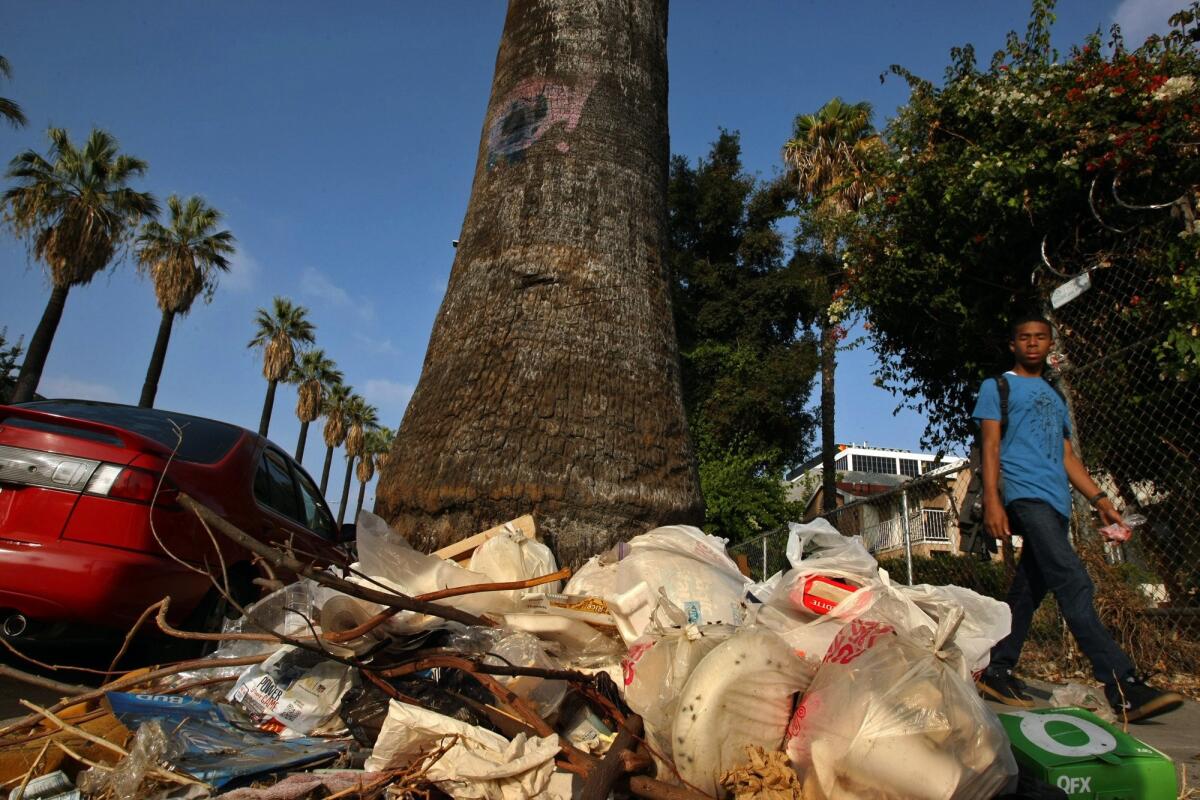Report calls for big changes in the way Los Angeles tackles trash

- Share via
Los Angeles city agencies should conduct a sweeping overhaul of the way they combat illegal dumping, by sending cleanup teams into neighborhoods, adding thousands of additional trash cans and relying more on data to locate the hardest hit areas, a high-level official said Tuesday.
In a 47-page report, a team led by City Administrative Officer Miguel Santana recommended the development of a “cleanliness rating index” for local streets, an education program targeting potential litterbugs and a more proactive approach to the issue overall.
Santana suggested the city’s Office of Community Beautification assign nonprofit groups to head into neighborhoods to identify the locations where furniture and other items have been dumped, a strategy similar to one used by the city for policing graffiti.
“Right now, we rely on a complaint-driven system where citizens or council offices essentially call in” to report illegal dumping, he said. “But if no one calls to pick up an abandoned couch, the couch could stay there months at a time.”
Tuesday’s report, titled “Improving Livability in Los Angeles,” comes six months after Santana’s office prepared an internal memo that warned that the city’s international image is threatened by the proliferation of litter, abandoned furniture, illegal dumping and homeless encampments. Irresponsible behavior, coupled with a lack of enforcement by City Hall, had led to a “constant state of uncleanliness” in some parts of the city, the memo said.
Santana’s report, which will be presented to the City Council on Wednesday, contains a series of recommendations from a working group formed to develop better strategies for tackling trash. They include:
- Development of a rating system to measure street cleanliness, similar to those found in cities like New York, San Francisco and Philadelphia. Under those programs, each street would receive a score based on the amount of trash and debris on sidewalks and in gutters.
- Triple the number of city trash cans placed on sidewalks in areas with heavy pedestrian activity. L.A. currently manages about 1,000 trash bins, compared with 4,800 in Washington and 25,000 in New York, according to Tuesday’s report.
- Greater enforcement of illegal dumping laws.
- Modernization of the city’s street-sweeping program, which cleans a smaller share of streets than is done in comparable cities. That operation, developed decades ago, does not take into account the places that generate the largest amounts of trash, according to the report.
- Creation of an education campaign to encourage residents to take pride in their neighborhoods. The effort would focus on promoting the city’s 311 hotline and teaming up with nonprofit organizations and businesses to raise awareness.
Councilman Curren Price, who represents the eastern part of South Los Angeles, said he would support the addition of trash cans on heavily trafficked streets such as Main Street, Broadway and Central Avenue. He also welcomed a greater reliance on data, if it is used to identify the neighborhoods with the greatest need.
“Our district has a lot of debris and bulky items that need picking up ... and we should be getting our share of those resources,” he said.
Mayor Eric Garcetti’s spokesman Jeff Millman did not directly address the recommendations from Santana’s office, instead noting that the city has budgeted $5 million for a new cleanup program. “Over the past year, Mayor Garcetti created new city teams to proactively clear the worst accumulations of trash from our neighborhoods, alleys, vacant lots and streets,” he said.
Santana said his team’s recommendations were prompted in part by Garcetti’s emphasis on basic services. One of the document’s major recommendations is to pursue a more data-driven approach to identifying neighborhoods with chronic litter, trash and illegal dumping problems.
“We have to use the same model as the LAPD, where there’s a focus on addressing the neediest areas in a way that can be measured and actually effectively monitored,” Santana said.
Follow @DavidZahniser and @bposton for what’s happening at Los Angeles City Hall.
More to Read
Sign up for Essential California
The most important California stories and recommendations in your inbox every morning.
You may occasionally receive promotional content from the Los Angeles Times.















